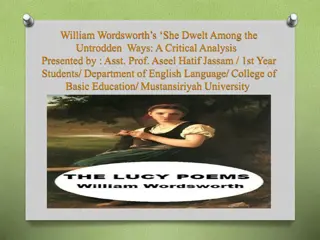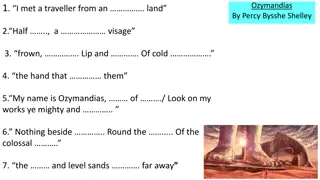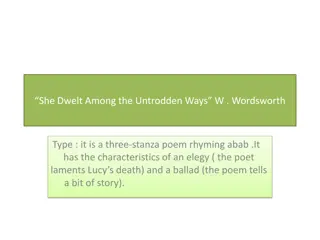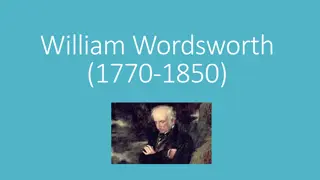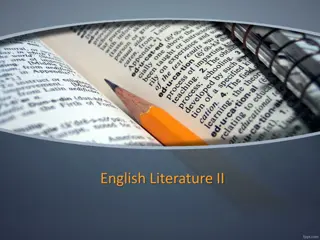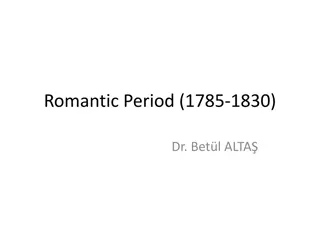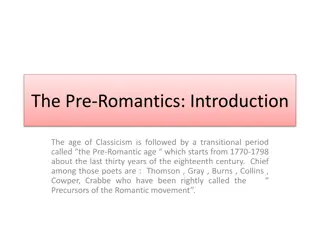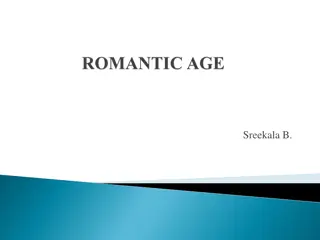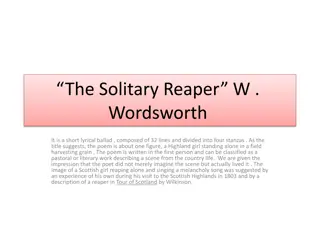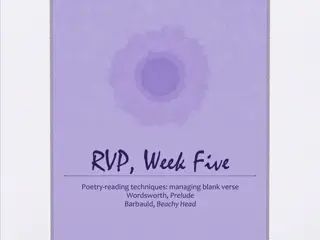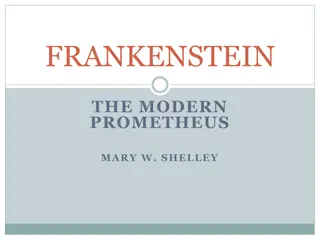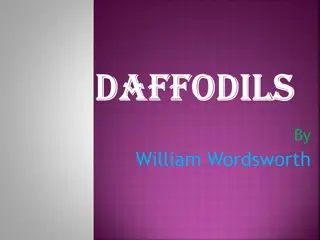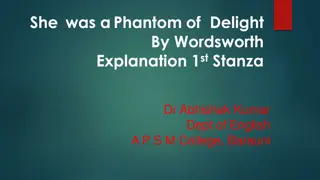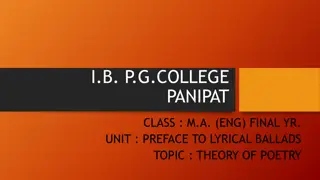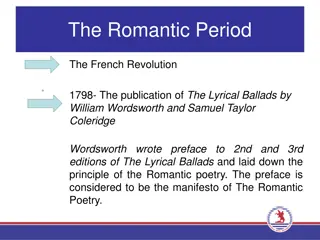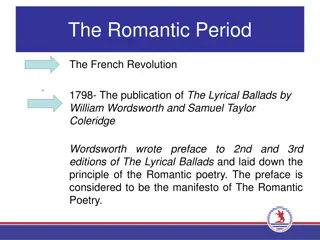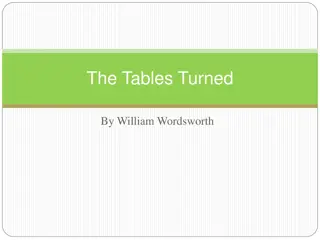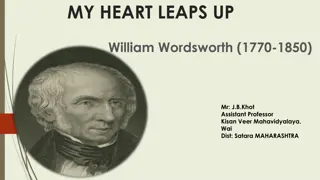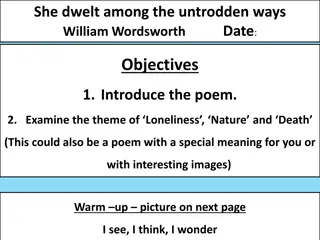The Romantic Age of Wordsworth: An Overview
The Romantic period in English literature, known as the Age of Wordsworth, emphasized emotions, individualism, nature's beauty, and common people's simplicity. William Wordsworth, a prominent English Romantic poet, co-authored Lyrical Ballads with Samuel Taylor Coleridge, and his notable work includes The Prelude. Despite initial challenges, his play The Borderers and experiences in Germany influenced his literary journey during this period.
Download Presentation

Please find below an Image/Link to download the presentation.
The content on the website is provided AS IS for your information and personal use only. It may not be sold, licensed, or shared on other websites without obtaining consent from the author.If you encounter any issues during the download, it is possible that the publisher has removed the file from their server.
You are allowed to download the files provided on this website for personal or commercial use, subject to the condition that they are used lawfully. All files are the property of their respective owners.
The content on the website is provided AS IS for your information and personal use only. It may not be sold, licensed, or shared on other websites without obtaining consent from the author.
E N D
Presentation Transcript
THE AGE OF WORDSWORTH (1798-1832)
INTRODUCTION: The Romantic period (The Age of Wordsworth) in English literature began in the late 1700s and lasted through the mid-1800s. Romanticism focuses on the emotional side of human nature, individualism, the beauty of the natural world and the simplicity of common people. Romantic authors value sentimental, heartfelt feelings and emotional experiences over historical and scientific facts.
WILLIAM WORDSWORTH In office 6 April 1843 23 April 1850 Monarch Victoria Preceded by Robert Southey Succeeded by Alfred, Lord Tennyson Personal details (1770-04-07)7 April 1770 Cockermouth, Cumberland, England Born 23 April 1850(1850-04-23) (aged 80) Rydal, Westmorland, England Died
William Wordsworth (7 April 1770 23 April 1850) was an English Romantic poet who, with Samuel Taylor Coleridge, helped to launch the Romantic Age in English literature with their joint publication Lyrical Ballads (1798). Wordsworth's magnum opus is generally considered to be The Prelude, a semi-autobiographical poem of his early years that he revised and expanded a number of times. It was posthumously titled and published by his wife in the year of his death, before which it was generally known as "the poem to Coleridge".[1]
The Borderers: Between 1795 1797, Wordsworth wrote his only play, The Borderers, a verse tragedy set during the reign of King Henry III of England, when Englishmen in the North Country came into conflict with Scottish border reivers. He attempted to get the play staged in November 1797, but it was rejected by Thomas Harris, the manager of the Covent Garden Theatre, who proclaimed it "impossible that the play should succeed in the representation". The rebuff was not received lightly by Wordsworth and the play was not published until 1842, after substantial revision.[19]
Wordsworth, Dorothy and Coleridge travelled to Germany in the autumn of 1798. While Coleridge was intellectually stimulated by the journey, its main effect on Wordsworth was to produce homesickness. During the harsh winter of 1798 99 Wordsworth lived with Dorothy in Goslar, and, despite extreme stress and loneliness, began work on the autobiographical piece that was later titled The Prelude
LAKE POETS Wordsworth, Coleridge and Southey came to be known as the "Lake Poets". Throughout this period many of Wordsworth's poems revolved around themes of death, endurance, separation and grief.
The Prelude or, Growth of a Poet's Mind; An Autobiographical Poem is an autobiographical poem in blank verse by the English poet William Wordsworth. Intended as the introduction to the more philosophical poem The Recluse, which Wordsworth never finished, The Prelude is an extremely personal work and reveals many details of Wordsworth's life.
Books of the 14-book Prelude: Introduction Childhood and School-Time School-Time (Continued) Residence at Cambridge Summer Vacation Books Cambridge and the Alps Residence in London Retrospect Love of Nature Leading to Love of Man Residence in France Residence in France (Continued) Residence in France (Concluded) Imagination and Taste, How Impaired and Restored Imagination and Taste, How Impaired and Restored (Concluded) Conclusion
Following the death of Robert Southey in 1843 Wordsworth became Poet Laureate. He initially refused the honour, saying that he was too old, but accepted when the Prime Minister, Robert Peel, assured him that "you shall have nothing required of you". Wordsworth thus became the only poet laureate to write no official verses. The sudden death of his daughter Dora in 1847 at age 42 was difficult for the aging poet to take and in his depression, he completely gave up writing new material.
The six best-known English authors are, in order of birth and with an example of their work: William Blake The Marriage of Heaven and Hell William Wordsworth The Prelude Samuel Taylor Coleridge The Rime of the Ancient Mariner George Gordon, Lord Byron Don Juan, "Childe Harold's Pilgrimage" Percy Bysshe Shelley Prometheus Unbound, "Adona s", "Ode to the West Wind", "Ozymandias" John Keats Great Odes, "Hyperion", "Endymion" Notable female poets include Felicia Dorothea Hemans, Anna Laetitia Barbauld, Charlotte Turner Smith, Mary Robinson, Hannah More, and Joanna Baillie.
Romantic Poetry Characteristics. Back From Set Rules. The poetry of the Romantic Revival is in direct contrast to that of Neoclassical. Interest in Rural Life. Common Life. Love of Liberty and Freedom. Escape to the Middle Ages.
Major Early Romantic Poets The following share characteristics of Romantic poets: William Blake (1757-1827): Blake s poetry dwelt upon his divine vision and rebelled against traditional poetic forms and techniques.
He created his own mythological world with man as the central figure. His more famous poems include The Lamb, The Tyger, The Chimney Sweeper, and The Clod and the Pebble. What makes Blake s poem especially attractive for teaching in high school is he often wrote two poems with the same title one poem negative and one poem positive, excellent for compare and contrast writing.
William Wordsworth (1770-1850): The most famous of the British Romantics, Wordsworth is considered the nature poet. He revolutionized poetic subjects, focusing on ordinary people in rustic settings. He, in addition, wrote about and considered the poet as superior to all other writers. His most famous poems include I Wandered Lonely as a Cloud, We are Seven, and I Travelled Among Unknown Men. Most high school literature textbooks have at least one poem by Wordsworth.
Samuel Taylor Coleridge (1772-1834): Coleridge and Wordsworth are often grouped together as The Lake Poets, and for good reason. Together they are credited as the founders of the Romantic movement. Coleridge s most famous poems, Rime of the Ancient Mariner, Kubla Kahn, and Christabel have a distinct supernatural element and strongly influenced American Romantics such as Poe and Hawthorne.
ROMANTIC POETS Lord Byron Samuel Tailor Coleridge John Keats
Later Romantic Poets The following share characteristics of later Romantic poets: Lord Byron (1788-1824): Lord Byron enjoyed unmatched popularity. Byron s most famous creations are his dark heroes, called Byronic heroes, who, in fact, were not heroes at all, but stood out from ordinary humans as larger than life.
The Byronic hero brooded, possessed insatiable appetites and incredible strength, rebelled against societal norms, and forced upon himself exile. Byron s most famous works include _Don Jua_n and Childe Harold s Pilgrimage. Lord Byron is generally reserved for university level literature courses and is rarely found in high school anthologies.
Percy Bysshe Shelley (1792-1822): Like all Romantics, Shelley was a radical non-conformist. He campaigned for social justice, even marrying the daughter of Mary Wollstonecraft, an English leader in the women s rights movement. His wife would later write Frankenstein. His most famous poems include Mutability, Ozymandias, and Ode to the West Wind.
John Keats (1795-1821): Perhaps the most popular Later Romantic poet, Keats accomplished great things during his short life. His Ode to a Nightingale, Ode on a Grecian Urn, and Ode on Melancholy find their way into anthologies throughout the English speaking world. Keats considered contact with poets as a threat to his independence and therefore shunned his contemporaries.
CONCLUSION: The Romantic period was one of major social change in England, due to depopulation of the countryside and rapid development of overcrowded industrial cities that took place roughly between 1798 and 1832.




